dB Drag Racing & Bass Race
Right from the days of the early loud systems, the lads who played their stuff as loud and heavy as they could at the traffic lights trying to beat each other were the very first informal car audio competitors. Thing is, they were the ones who got noticed and gave the sound quality merchants the most grief, since they are inevitably tarred with the same brush as the bass heads. All car audio is just boom isn’t it? Well it isn’t but the dB Drag competition format most certainly is. However, many of the tweaks love a bit of throb on the sly and some are even open about it. They’ll have a proper sound quality setting on their equaliser but will often have a street thump setting in there too. Although they have a stringent statement of professionalism and courtesy attached to the format, this is the one your out and out bass monsters will enter. Some of these guys would take a Disturbing the Peace rap as a badge of honour.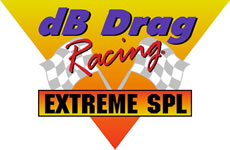
That it is called decibel drag racing is simply descriptive. For in a perfect analogy the cars go from mild to wild right up to things that just ain’t street legal, just like top fuel dragsters. One thing to get out of the way first is to know that the deepest bass does not hit the meters as hard as a highish 70Hz tone, so you get street boys who like to wobble the windows at the burger joint and you get the hardcore numbers chasers whose cars are a bit odd versus the normal people’s cars. But then, by the time they are that bass-addled, they are surely nutty anyway. I love them to bits and entirely understand.
Here’s how dB Drag Racing works. The cars start as ‘Street’ and are limited to systems that are like ones you might get by going into a shop and asking for a normal bass install. You are allowed subs on your rear deck but basically it all has to be in the boot.
As you go up the classes, the building and use regulations allow more and more lunacy. It starts with allowing you to sling out your back seats and use a woofer wall right behind you – you do have to be able to stretch a piece of string across the B pillars and run it up and down without touching any of the kit or builds.
It gradually becomes more way out until you are using regulations that allow you to install up to four inch thick Plexiglas instead of normal windows, use big steel straps over the front of your windscreen and even have batteries in boxes under your car and a headunit that is in a podium outside the car and not even installed within it. Some guys use a ‘burp’ button. This is when you get your approved tone blaring through the headunit (from CD only – no tone gennys are allowed) and press a button to release a brief BURP of bass. They get thirty seconds to do their thing but this brief burp is often all they will do to get the number they need to go on to the next round. After all, a good competitor will save his electrical energy.
Street Division
Street A Class – A maximum of 1 subwoofer amplifier (or 2 externally bridged monoblock amplifiers) may be used. A maximum TOTAL of 2 electrical conductors may be used to connect the amplifier(s) to the woofer(s).
One 12-inch woofer
OR a maximum of two 10-inch woofers
OR a maximum of three 8-inch woofers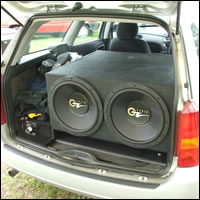 Street B Class – A maximum of 2 subwoofer amplifiers (or 4 externally bridged monoblock amplifiers) may be used. A maximum TOTAL of 4 electrical conductors may be used to connect the amplifier(s) to the woofer(s).
Street B Class – A maximum of 2 subwoofer amplifiers (or 4 externally bridged monoblock amplifiers) may be used. A maximum TOTAL of 4 electrical conductors may be used to connect the amplifier(s) to the woofer(s).
One 15-inch woofer
OR a maximum of two 12-inch woofers
OR a maximum of three 10-inch woofers
OR a maximum of four 8-inch woofers
Street C Class – A maximum of 4 subwoofer amplifiers (or 8 externally bridged monoblock amplifiers) may be used. A maximum TOTAL of 8 electrical conductors may be used to connect the amplifier(s) to the woofer(s).
One 18-inch woofer
OR a maximum of two 15-inch woofers
OR a maximum of four 12-inch woofers
OR a maximum of six 10-inch woofers
OR a maximum of eight 8-inch woofers
Additional Guidelines for the Street Division:
Amplifiers used for non-subwoofer applications will not be counted.
Amplifiers that are constructed in such a way as to circumvent the amp quantity limitation may be prohibited from use in this division or may count as multiple amplifiers. Cargo vans and commercial vehicles are prohibited from competing in the Street Division.
Street Max Division
Street Max 1-2 Class – 1-2 Woofers. A maximum of 2 subwoofer amplifiers (or 4 externally bridged monoblock amplifiers) may be used. A maximum TOTAL of 4 electrical conductors may be used to connect the amplifier(s) to the woofer(s).
Street Max 3-4 Class – 3-4 Woofers. A maximum of 4 subwoofer amplifiers (or 8 externally bridged monoblock amplifiers) may be used. A maximum TOTAL of 8 electrical conductors may be used to connect the amplifier(s) to the woofer(s).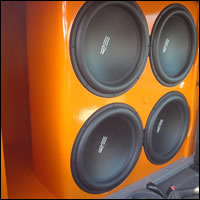
Additional Guidelines for the Street Max Division:
Amplifiers used for non-subwoofer applications will not be counted.
Amplifiers that are constructed in such a way as to circumvent the amp quantity limitation may be prohibited from use in this division or may count as multiple amplifiers.
Super Street Division
Super Street 1-2 NW Class – 1-2 Woofers, No Wall
Super Street 1-2 Class – 1-2 Woofers
Super Street 3-4 Class – 3-4 Woofers
Super Street 5+ Class – 5+ Woofers
Extreme Division
Extreme 1 Class – 1 Woofer
Extreme 2 Class – 2 Woofers
Extreme 3-4 Class – 3-4 Woofers
Extreme 5+ Class – 5+ Woofers
Monster Division
Monster Class – The Monster Division is an exhibition-only class. This class is not eligible for the Extreme Cup or overall World Record. Only class records may be established. Eligibility requirements (such as points, certified score, etc.) are waived for this class. Participation at the World Finals is by invitation only.
The classes listed above are the recommended standard classes for dB Drag Racing. Typically, all of these classes will be offered at multi-point events. However, if there are fewer than 4 entries in a given class, or if the event is a single-point event, the show promoter may, at his discretion, combine one or more classes in order to fully populate the elimination brackets. In any case, the number of classes offered, and their specific breakdown, is at the discretion of the show promoter. You can find out the full rules at www.termpro.com who host the dB Drag and Bass Race thing. The definitive UK application of the rules is best checked at www.dbdrag.co.uk, where you also enter competitions.
Bass Race
Bass racing is a brilliant idea and is more about controlling your knob than out and out loudness. You qualify to be in a ten dB  ‘bracket’ and then you compete. What you need to do is work out how loud your system is and try to hit an average score. The two cars competing go head to head and play bass for 30 seconds. As they play, the meter records an average. If you reckon you will be between 110dB and 120dB you try to average under 119.9dB. If you get over excited and crank the volume too hard at the end, you go over and lose by disqualification. It is very like bracket racing on the real drag strip.
‘bracket’ and then you compete. What you need to do is work out how loud your system is and try to hit an average score. The two cars competing go head to head and play bass for 30 seconds. As they play, the meter records an average. If you reckon you will be between 110dB and 120dB you try to average under 119.9dB. If you get over excited and crank the volume too hard at the end, you go over and lose by disqualification. It is very like bracket racing on the real drag strip.
It’s about control and repeatability as well as coolness under pressure. It always the laid back who win Bass Race. It’s brilliant fun to commentate and I have had a go. The big boys are especially cool as they try to hold between 140dB and 150dB. If one gets a bit ahead – as they want to see a score as close to the maximum without going over, so as to beat their opponent, you can be suckered into over bassing it and blowing out. The really cool thing is that you can compete with very little kit. Any sort of reasonably potent bass system can compete, even a single eight incher.
‘Bass Race is a new format of auto sound competition specifically tailored for ‘real’ auto sound systems.’
The basic rules.
Contestants must play music (instead of tones, sweeps, etc.)
Contestants are classified by the performance of their system (as opposed to equipment, cost, experience, etc.)
Contestants are required to skilfully control the operation of their sound system. (This added dimension adds excitement to the contest.)
A Bass Race competition is comprises two parts. Qualifying & Eliminations.
Qualifying
During qualifying, each contestant’s sound system is measured with an SPL (Sound Pressure Level) meter. This meter measures the average SPL of the contestant’s sound system in dB over a period of 30 seconds. (You can only use music CDs while competing. In addition, all doors, windows, and other openings to the vehicle must be closed.) At the end of the 30 second measurement period, the contestant will be placed into one of six Bass Race classes based upon their score:
119.9dB and under
120.0dB to 129.9dB
130.0dB to 139.9dB
140.0dB to 149.9dB
150.0dB to 159.9dB
160.0dB and up
This method of classification groups contestants with similar scores in the same class. The result is a contest that is fair for the contestants and exciting for everyone!
Eliminations
After everyone has had an opportunity to qualify, the eight loudest contestants in each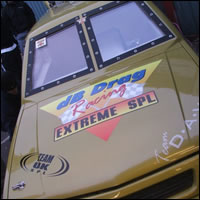 class are randomly paired against one another in the quarter-final elimination bracket. Each pairing of competitors goes up against one another head-to-head. The winner advances to the next round and the loser is eliminated from the contest. This continues (semi-finals and finals) until there is a winner for each class.
class are randomly paired against one another in the quarter-final elimination bracket. Each pairing of competitors goes up against one another head-to-head. The winner advances to the next round and the loser is eliminated from the contest. This continues (semi-finals and finals) until there is a winner for each class.
The elimination rounds are where things get tricky. The following violations will result in a score of ZERO.
Red Light – Playing your sound system BEFORE the 30 second clock begins.
Over Shot – Exceeding your classes’ maximum score at any time during the run. (Example: A contestant scoring a 132.0 at any time during an elimination run in the 120.0 – 129.9 class would result in a score of ZERO.)
Over Rev – Revving the motor in excess of 2000 RPM.
Venting – Opening a door, trunk, hatch, sun-roof, window, etc. during the run.
High Freq – Playing a bass note in excess of 80 Hz to obtain a maximum average score.
Test Tones – Using test tones or sine sweeps for program material.
Tie Breaker
In the case of a tie, the following steps will take place to determine the winner.
First Tie-Breaker – Re-run the round.
Second Tie-Breaker – Shut down the engines and re-run the round.
Third Tie-Breaker – Shut down the engines and re-run the round by operating the system from outside the vehicle.
Although the rules for Bass Race may seem simple, here are some tips that will help you improve your score.
Tips, Tricks, and Techniques
Music – Find a commercially available music CD (no test tones, etc.) that contains a minimum of 30 seconds of bass. Each sound system is different so don’t hesitate to experiment to find the song that works best for you.
Average – To maximize your score, you need to fully understand how the SPL meter averages your score. The following examples describe this process
Example 1:
If in the 1st ‘second of time’ you have a score of 90 dB, your average score is 90 dB.
If in the 2nd ‘second of time’ you have a score of 100 dB, your average score will be (90+100) / 2 = 95 dB.
If in the 3rd ‘second of time’ you have a score of 120 dB, your average score will be (90+100+120) / 3 = 103 dB.
The same process is carried out for each second of measurement in the 30 second judging period to determine your final average score.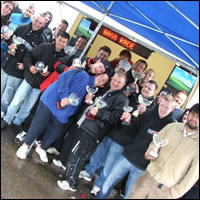 Example 2:
Example 2:
If in the 1st ‘second of time’ you have a score 0 dB, your average score is 0 dB.
If in the 2nd ‘second of time’ you have a score of 0 dB, your average score will be 0 dB.
If in the 3rd ‘second of time’ you have a score of 120 dB, your average score will be (0+0+120) / 3 = 40 dB.
As you can see, reaction time is crucial. But be careful. If you play your system prior to the start of measurement, you will ‘Red Light’ and your score for the run will be set to 0.
Be Prepared – Have your CD ready. Reaction time is very important. You want bass music to begin as soon as the SPL meter starts to measure. Songs with long introductions (and no bass) are not recommended. Music tracks with a strong and continuous bass beat work best.
Stay Informed – Once in the lanes, park your car so that you can clearly see the display score board. The information displayed here is critical to controlling your sound system. Remember, you want to maximize your average score WITHOUT busting out of your class (Over Shot). For example: If you are competing in the 120.0 to 129.9 class, the ideal score would be a 129.9. This is as loud as you can play your system without exceeding your class maximum.
So Bass Race is like balancing a stick on your nose while roller skating. On ice. And you don’t need to have a huge bass system to do it. It is completely brilliant fun and once more people know about it, I reckon it could be huge. Get Involved!
www.dbdrag.co.uk

